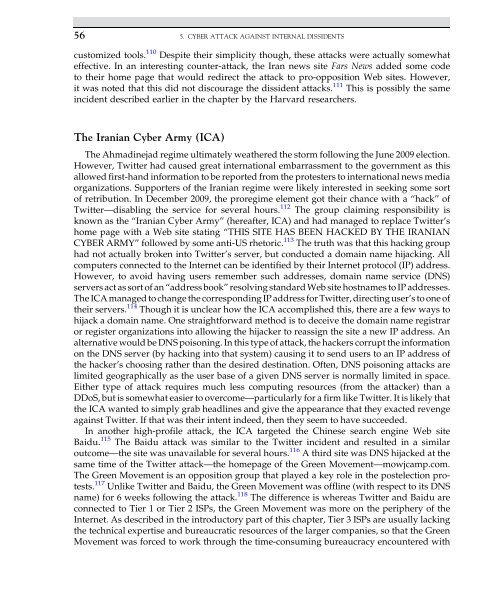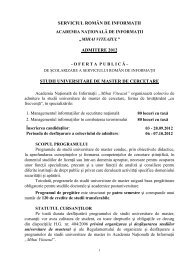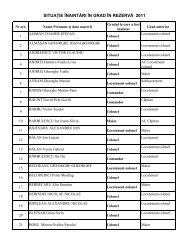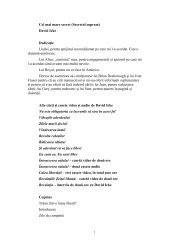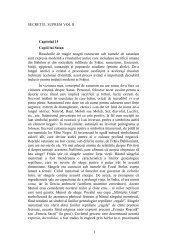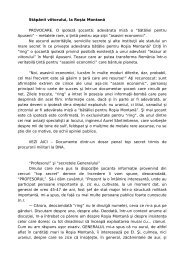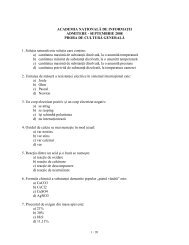Introduction to Cyber-Warfare - Proiect SEMPER FIDELIS
Introduction to Cyber-Warfare - Proiect SEMPER FIDELIS
Introduction to Cyber-Warfare - Proiect SEMPER FIDELIS
You also want an ePaper? Increase the reach of your titles
YUMPU automatically turns print PDFs into web optimized ePapers that Google loves.
56 5. CYBER ATTACK AGAINST INTERNAL DISSIDENTScus<strong>to</strong>mized <strong>to</strong>ols. 110 Despite their simplicity though, these attacks were actually somewhateffective. In an interesting counter-attack, the Iran news site Fars News added some code<strong>to</strong> their home page that would redirect the attack <strong>to</strong> pro-opposition Web sites. However,it was noted that this did not discourage the dissident attacks. 111 This is possibly the sameincident described earlier in the chapter by the Harvard researchers.The Iranian <strong>Cyber</strong> Army (ICA)The Ahmadinejad regime ultimately weathered the s<strong>to</strong>rm following the June 2009 election.However, Twitter had caused great international embarrassment <strong>to</strong> the government as thisallowed first-hand information <strong>to</strong> be reported from the protesters <strong>to</strong> international news mediaorganizations. Supporters of the Iranian regime were likely interested in seeking some sor<strong>to</strong>f retribution. In December 2009, the proregime element got their chance with a “hack” ofTwitter—disabling the service for several hours. 112 The group claiming responsibility isknown as the “Iranian <strong>Cyber</strong> Army” (hereafter, ICA) and had managed <strong>to</strong> replace Twitter’shome page with a Web site stating “THIS SITE HAS BEEN HACKED BY THE IRANIANCYBER ARMY” followed by some anti-US rhe<strong>to</strong>ric. 113 The truth was that this hacking grouphad not actually broken in<strong>to</strong> Twitter’s server, but conducted a domain name hijacking. Allcomputers connected <strong>to</strong> the Internet can be identified by their Internet pro<strong>to</strong>col (IP) address.However, <strong>to</strong> avoid having users remember such addresses, domain name service (DNS)servers act as sort of an “address book” resolving standard Web site hostnames <strong>to</strong> IP addresses.The ICA managed <strong>to</strong> change the corresponding IP address for Twitter, directing user’s <strong>to</strong> one oftheir servers. 114 Though it is unclear how the ICA accomplished this, there are a few ways <strong>to</strong>hijack a domain name. One straightforward method is <strong>to</strong> deceive the domain name registraror register organizations in<strong>to</strong> allowing the hijacker <strong>to</strong> reassign the site a new IP address. Analternative would be DNS poisoning. In this type of attack, the hackers corrupt the informationon the DNS server (by hacking in<strong>to</strong> that system) causing it <strong>to</strong> send users <strong>to</strong> an IP address ofthe hacker’s choosing rather than the desired destination. Often, DNS poisoning attacks arelimited geographically as the user base of a given DNS server is normally limited in space.Either type of attack requires much less computing resources (from the attacker) than aDDoS, but is somewhat easier <strong>to</strong> overcome—particularly for a firm like Twitter. It is likely thatthe ICA wanted <strong>to</strong> simply grab headlines and give the appearance that they exacted revengeagainst Twitter. If that was their intent indeed, then they seem <strong>to</strong> have succeeded.In another high-profile attack, the ICA targeted the Chinese search engine Web siteBaidu. 115 The Baidu attack was similar <strong>to</strong> the Twitter incident and resulted in a similaroutcome—the site was unavailable for several hours. 116 A third site was DNS hijacked at thesame time of the Twitter attack—the homepage of the Green Movement—mowjcamp.com.The Green Movement is an opposition group that played a key role in the postelection protests.117 Unlike Twitter and Baidu, the Green Movement was offline (with respect <strong>to</strong> its DNSname) for 6 weeks following the attack. 118 The difference is whereas Twitter and Baidu areconnected <strong>to</strong> Tier 1 or Tier 2 ISPs, the Green Movement was more on the periphery of theInternet. As described in the introduc<strong>to</strong>ry part of this chapter, Tier 3 ISPs are usually lackingthe technical expertise and bureaucratic resources of the larger companies, so that the GreenMovement was forced <strong>to</strong> work through the time-consuming bureaucracy encountered with


